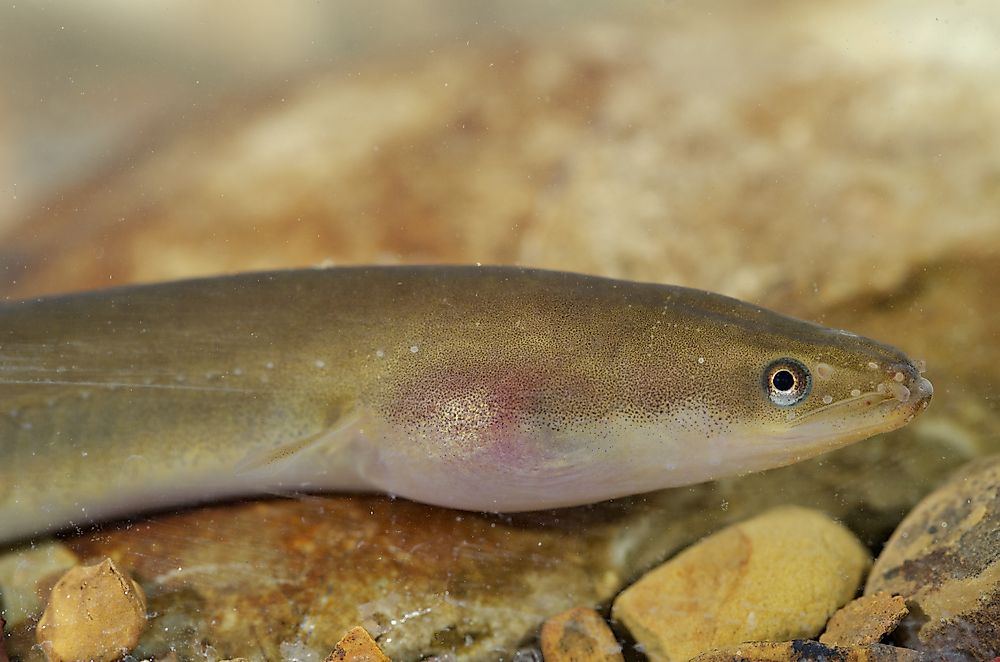Native Fish Species Of Libya

Libya is located in North Africa and is part of the Maghreb Region. It is bordered by Egypt, Sudan, Chad, Niger, Algeria and Tunisia. Despite the country being one of the most arid on earth (90% of it is composed as desert), there is still plenty of water for fish species. The country has a long coastline and the occasional oasis, such as the town of Ubari. The country also has lakes for fish species, like the Benghazi Lake or the Ouau en Namu Lakes. This article will discuss a few of these native fish species, including their physical characteristics, habitats, their current conservation status and any major threats that they face.
The native fish of Libya:
European Eel
The European eel, scientific name Anguilla anguilla, is a species of eel that is part of the Anguillidae family of ray-finned fish. A fully grown adult of the species is usually between 2.0 to 2.6 feet in length, but they have been known to grow as long as nearly five feet. As a young adult, the species has a brown/yellow color on its sides and belly. Once fully grown adults, their sides become silver in color, while their belly turns white. This species is found in various bodies of water such as streams, rivers, estuaries, lagoons and lakes. This is as long as these bodies are connected to the sea, as the European eel reproduces with a catadromous migration pattern, meaning it goes from fresh water to the sea to reproduce. This species is found along all of the coasts in the Mediterranean Ocean and up along every coastal European country, as well Switzerland and the Czech Republic, who are landlocked but have river access to the ocean. According to the International Union for Conservation of Nature (IUCN) Red List, the European Eel has been listed as a critically endangered species since 2008 and its population is declining. Some of the major threats that this species is facing include migration barriers, climate change, disease, habitat loss, pollution and over-hunting.
Libyan Pupfish
The Libyan Pupfish, scientific name Aphanius desioi, is a species of pupfish that is a member of the Cyprinodontidae family of ray-finned fish. Male adults of this species of fish have been known to grow to be up to 1.96 inches in length, but besides this not much else is known about its size and physical characteristics. This species is known to be found in connecting canals, springs and sulphur lakes in the Al Wahat District of Northern Libya, from the Ain el-Braghl Lake to the city of El Agheila in the Sirtica desert region. This species is endemic to Libya, meaning that it can only be found in this country. There is no known information on its current population trend but its population is not severely fragmented. The species is known to be used in the aquarium trade, but currently has no known major threats.
True Big-Scale Tetra
The true big-cale tetra, scientific name Brycinus macrolepidotus, is a species of ray-finned fish that is a member of the Alestidae family. This family is apart of the Characiformes order of ray-finned fish and can only be found in Africa. Adults of this species have been known to reach a maximum weight of 4.4 pounds and reach a maximum length of 1.73 feet. This species has silver-greenish looking scales with a distinctive orange-red tail. This species is found in rivers and lakes, although it is more commonly found in rivers. It is found throughout a wide variety of different countries in most of the inter-tropical parts of Northern Africa, Northeast Africa, Eastern Africa, Western Africa and Central Africa. According to the IUCN Red List, the True Big-Scale Tetra has been listed as a species of least concern since 2009, but its current population trend is unknown. The population of this species has a wide distribution and it is not severely fragmented. A major factor that threatens this species is heavy fishing, particularly from commercial fisheries.
What is being done to help the native fish of Libya?
There are a number of different things that are being done to help preserve the native fish of Libya. There are fisheries set up to breed and help conserve the populations of fish that are experiencing a declining population. There are also national parks and protected reserves, some of which encompass areas where these fish live ensuring that they have a safe habitat. The government of Libya has also passed laws to try and regulate marine fisheries to prevent over-fishing from taking place.
Native Fish Species Of Libya
| Native Fish Species of Libya | Scientific Name |
|---|---|
| Allis Shad | Alosa alosa |
| Black-Striped Pipefish | Syngnathus abaster |
| Big-Scale Sand Smelt | Atherina boyeri |
| Sea Lamprey | Petromyzon marinus |
| True Big-Scale Tetra | Brycinus macrolepidotus |
| Leaping Mullet | Liza saliens |
| North African Catfish | Clarias gariepinus |
| Libyan Pupfish | Aphanius desioi |
| European Eel | Anguilla anguilla |
| Rock Goby | Gobius paganellus |











